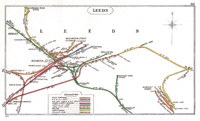LNER NPCS - clerestory BGs
There were two clerestory BGs inherited by the LNER and they served until 1947-51 :
45' GNR - with double truss-posts.
46'6" ECJS - with single truss-posts.
This is a historical compilation. The D&S kit for the ECJS van is in a modelling topic (see link below).
New additions placed here temporarily.
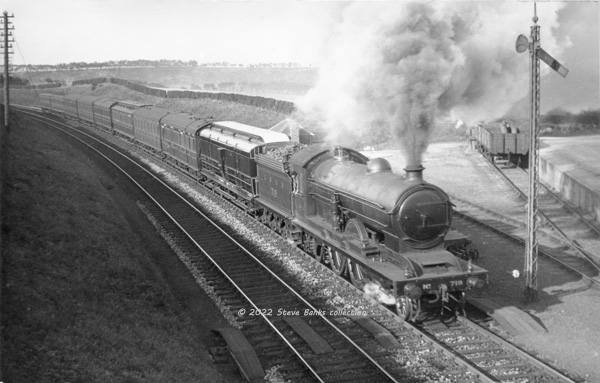
Raven-built Atlantic C7 No 719 sometime between 1925-28 forges round the curve at Pease Siding on the 1:96 ascent to Penmanshiel Tunnel with a southbound express of nine medium calibre carriages. I'll try to establish the working later. Behind the tender is a beautifully refurbished ECJS clerestory BG. Photo: LGRP 20390, author's collection.
- click on the picture for an enlargement
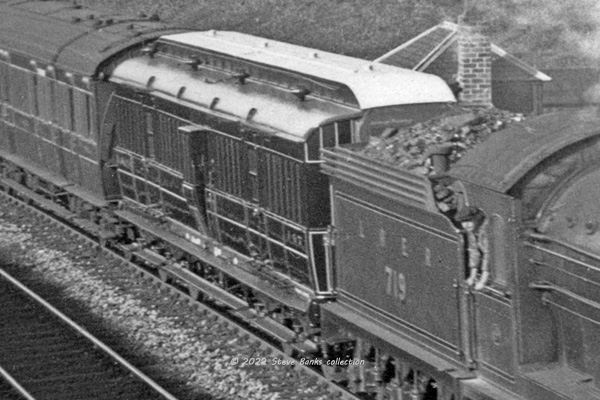
An enlargement of the BG shows the details. I have adjusted the tones so that details on the roof can be seen. No 147 is being carried, as renumbered between 1925-28. A few years later the lining was to be dropped and this splendour was to disappear. The immaculately clean white roof suggests its first working after leaving the works. Don't expect it would have been quite the same the other side of Penmanshiel Tunnel! The lower footstep was also still in place. Photo: author's collection.
- click on the picture for an enlargement
GNR 45' BG
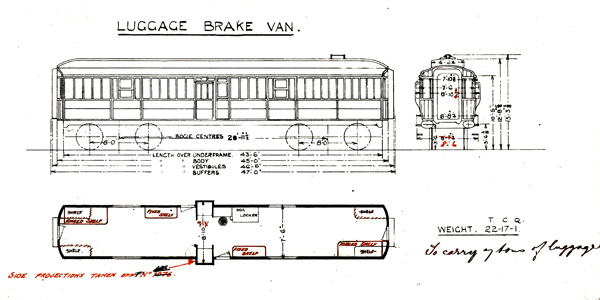
This drawing for GN Diagram 290 is an extract from a copy of the Diagram Book held by the NRM in which I have tried to remove the (tungsten light) brown cast while leaving the annotations in red ink clear to see. Note the title of "Luggage brake van" - in LNER days such vehicles were termed more simply as "Brake van". Running numbers of the 19 built were:
GNR - 944/46/67/85/92/98, 1001/2/11/22/27/29/39/64/76/77, 1515/16, 2543
LNER - 471-489
The inked-on rating was to carry 7 tons. Note how the number of shelves was reduced and hinged ones fitted. This took place during the Great War in 1916-17.
The GNR Diagram does not show any torpedo vents on the roof and neither do any of the LNER-period photographs (unlike the ECJS version shown below).
Guard's duckets were provided on both sides although No.1077 (LNER 486) had one of them removed; no date is given but it would have been in LNER days. They were condemned gradually between 1936-1947.
- click on the picture for an enlargement
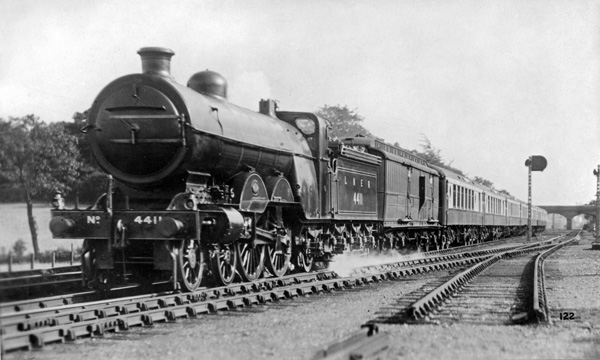
New addition. C1 No 4411 head the Down Harrogate Pullman in the early 1920s past Greenwood with a GN 45' BG behind the tender. There was a shortage of brake-ended Pullman cars at first and a bogie van had to be deployed (and later when a brake-ended Pullman car was not available). Photo: Railway Photographs.
- click on the picture for an enlargement
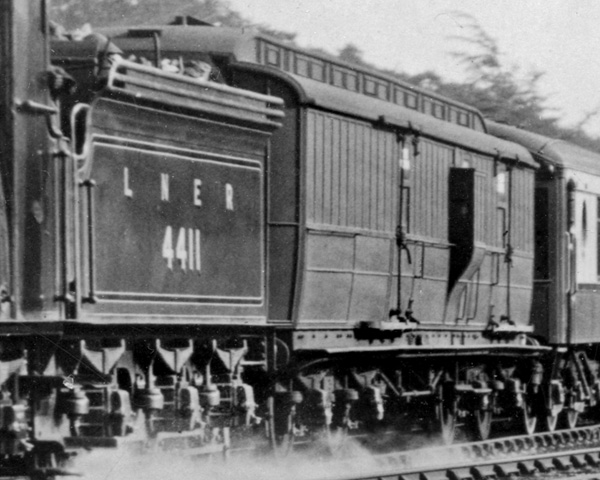
An enlargement of the GN bogie van shows the double trussposts, the most visible difference between it and the ECJS design. Photo: Railway Photographs.
- click on the picture for an enlargement
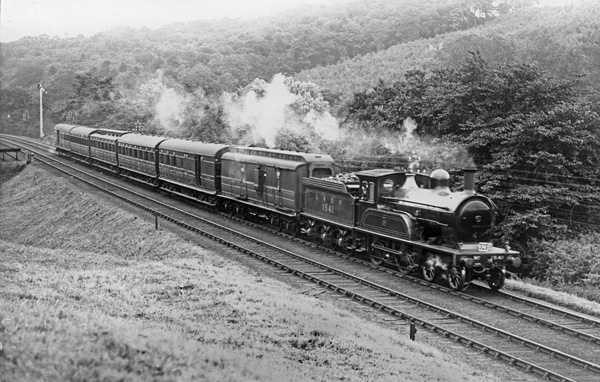
This view from around 1925-28 can be resolved in some detail. It shows a working on the NE Area and was taken between Castle Howard and York with D22 No 1541 in one of the Leeds-York-Scarborough circuits for 5-sets which were still made up entirely with ex-NER stock (BT,CL,CL,T,BT). In summer when workings on this line could be intense, tablets were carried on all the trains and numbers in the low 300s indicated normal services.
Each set made two out and back trips each day, starting from Leeds or Scarborough, and the picture shows a turn for a Neville Hill loco working back with the 1.25pm from Scarborough just south of Castle Howard. Behind the loco, a through van from the GN Section has been attached that will come off at York and be sent on back to King's Cross and for which an ex-GNR 45ft clerestory BG had been deployed. Photo: H. Gordon Tidey, Real Photos.
- click on the picture for an enlargement
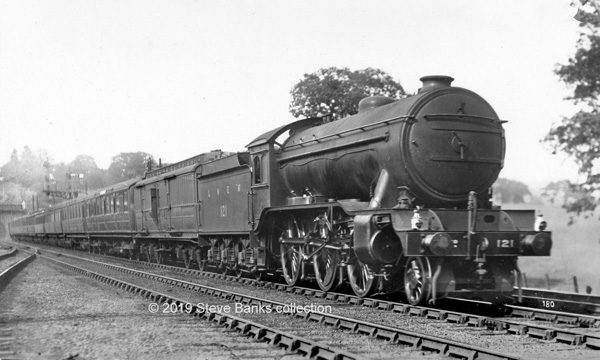
A scene at Greenwood in the late 1920s shows K3 No 121 with what looks like a relief Up express. A BG has been placed behind the tender, an ex-GNR 45' one. Photo: author's collection.
Click on the image for an enlargement
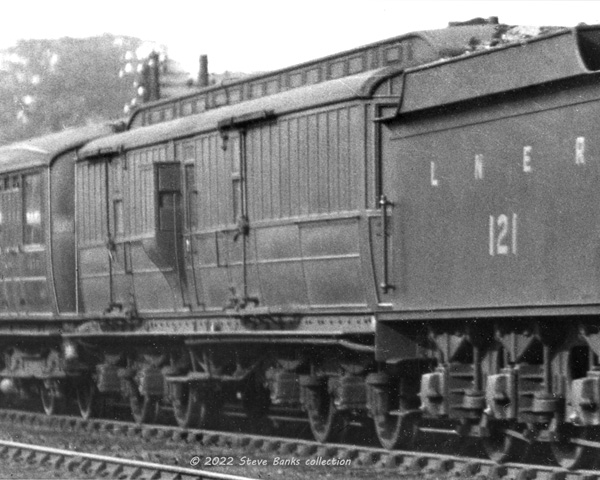
An enlargement taken from another print of the same image. Note the absence of destination board racks on the roof. Railway Photographs postcard: author's collection.
Click on the image for an enlargement
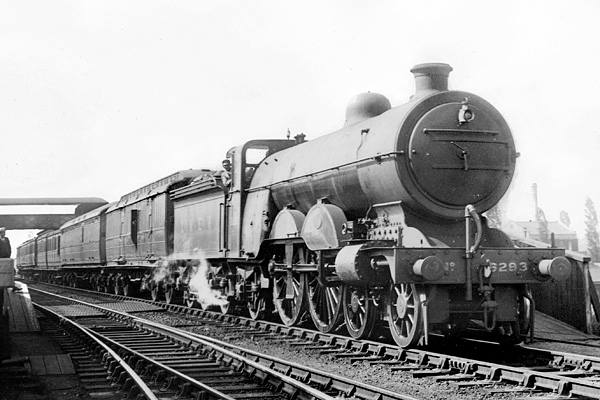
C1 3293 is at the head of a secondary passenger train with one of these vans behind the tender. It is just possible to make out the double truss posts. Note the triple destination boards on the roof.
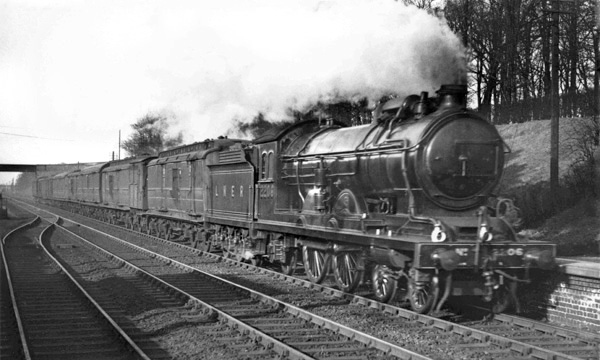
A stunning picture from the early 1930s of C7 No 2206 at Croft Spa - between Darlington and York - with a parcels/ECS/stock train - I've listed all that these trains used to carry because the simple name of "parcels train" can be a bit simplistic!
The head of the train has two clerestory BGs, both of them 45' ex-GNR. The leading four vehicles are clear enough to be identified:
BG |
ex-GNR |
45' |
Horse box |
GWR |
- old type with no fodder compartment |
BG |
ex-GNR |
45' |
BV |
ex-GNR |
51'1 1/2" |
... remainder unclear... |
So many ex-GNR bogie vans in a train on the North Eastern Area heading towards the GN Section says rather a lot about non-use of the ex-NER 6w van for inter-Area/Section services! The GWR horse box was being returned empty, probably taken out at York and sent on via the GC Section to Banbury. Photo: Author's collection.
- click on the picture for an enlargement
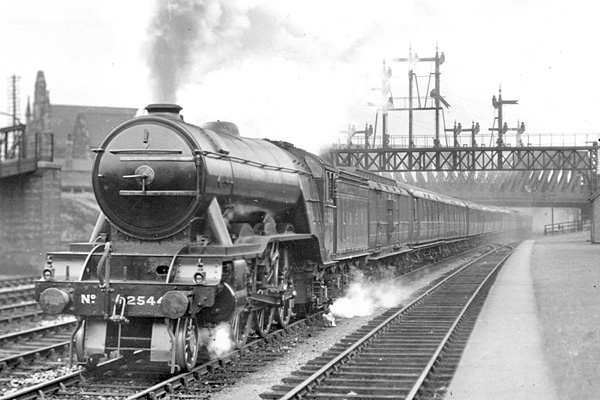
2544 Lemberg works hard to get a heavy express of around 13 coaches away from York under the Holgate Rd. bridge, date around the early 1930s. At the head is an ex-GNR clerestory BG. Not the most useful picture for details of the van but another example of how widely this type of vehicle was used alongside Gresley coaches and how pleasing the contrast can be.
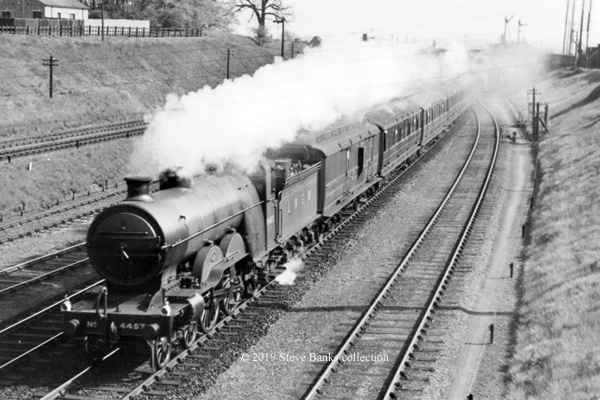
C1 No 4457 is passing Sandy with a Down excursion on Saturday 1st May 1937. Destination boards are few and excursion details have been posted on the leading three carriages. Behind the tender is an ex-GNR 45' clerestory BG, still going strong in the late '30s. Photo: Les Hanson.
Click on the image for an enlargement
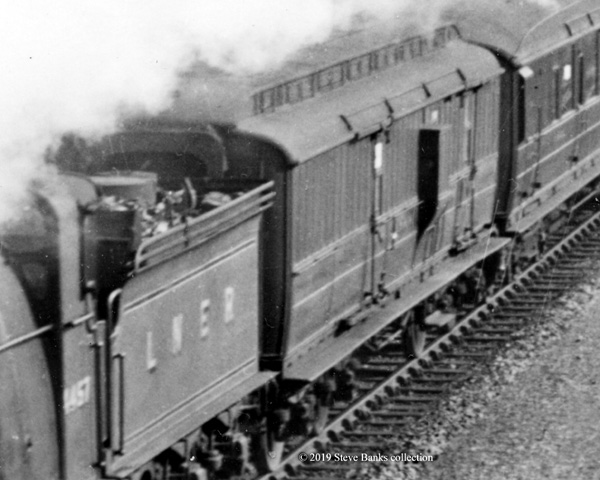
A closer view shows the similar features as the 1920s view plus triple destination racks on the roof. Note the absence of torpedo vents.
ECJS 46'6" BG
There were two Diagrams, detail changes and multiple renumbering that is more relevant to modellers so, to avoid clutter here, I've placed that in the Modelling topic (see link below).
During the 1920s as more modern BGs were built for the ECJS fleet, some of these clerestory vans were scrapped while others were cascaded into general service in the following Sections:
NB (2) 1926
GN (1) 1928
GE (4) 1928-29
Hence by summer 1929, none remained in the ECJS fleet - all the survivors were in less important duties where they lasted until:
1943 (GN)
1949 (GE)
1951 (NB)
The LNER-period pictures below show several changes to some of the fittings, essentially simplifications. They cannot be dated precisely but appear to have been cumulative during the 1920s.
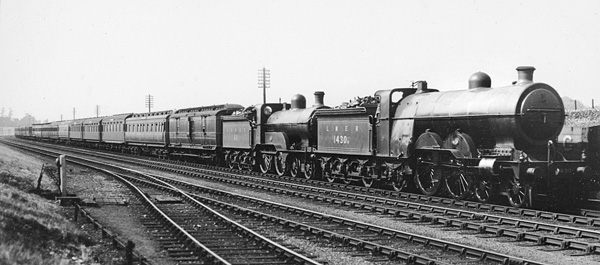
In this view from 1924, two ex-GNR locos (C1 1430 and D165) are hauling a heavy East Coast express with such a van at the head. The single truss post can just be seen on the original print. This example has single destination board holders on the roof and the lower, suspended footboard between the bogies.
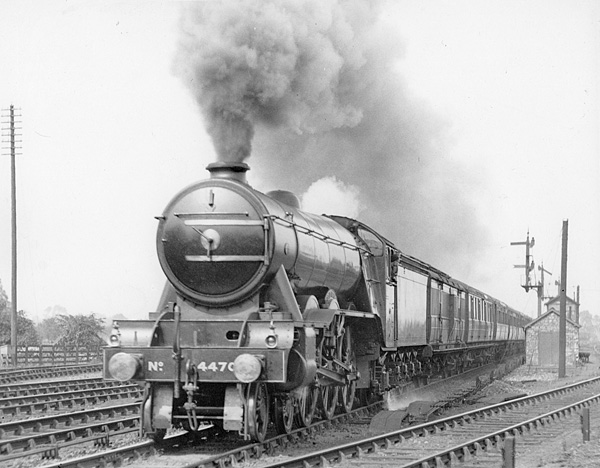
A stirring view at Dringhouses in the late 1920s as A1 4470 Great Northern thunders past the signal box and ex-NER signals with an ECML express. Behind the tender is an ex-ECJS clerestory BG.
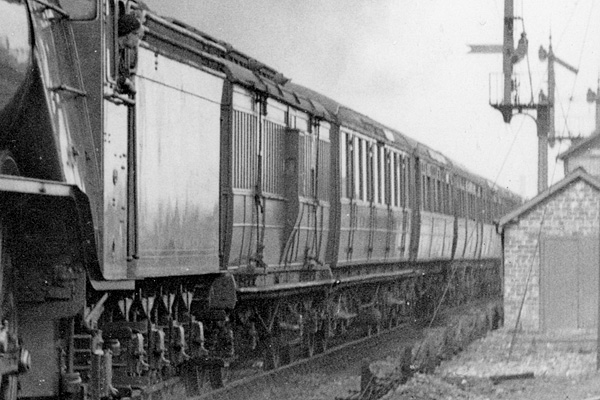
An enlargement of the BG shows the principal distinguishing feature compared with the GNR design: the single trust post on each side. Triple destination board holders are on the roof. The lower footstep has already been removed.
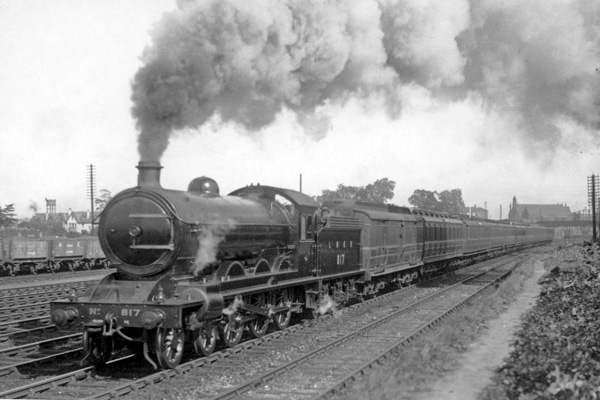
Another view from the 1920s shows ex-NER B15 No 817 in sparkling condition as it leaves York with an Up express whose formation includes several 12w clerestories. Behind the tender is an ECJS BG.

A closer view shows the lower guard's step well, and the single truss-post. Once again, the lower steps between the bogies has been removed. On the roof, the destination board holders on the roof have also been removed, which means that there were three different configurations of this feature. This is the simplest version of this ECJS BG and how it would have served through later LNER and BR days.
The headstocks
A clearly visible headstock in the enlarged pictures extends outside the solebars. There were cases where the solebars and headstocks were the same width, including carriages built for the ECJS. But this was not one of them, as the extract below shows, a detail view from the ECJS Diagram per Cowlairs who built the first three and which I have abstracted and tidied up from Ken Hoole's "The Illustrated History of East Coast Joint Stock". In that same book there is an occasional glimpse of this design feature on other carriages (see p.75 and 79, for example, where both styles are clear to see). Yet, looking closer at the enlargements of the train pictures, I'm prepared to be swayed that I'm seeing not so much ends that were fully radiused as having corners, possibly a variation by York which built the final 16? Answers please on a postcard!
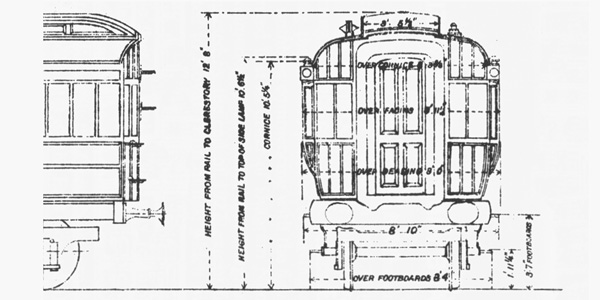
- click on the picture for an enlargement
Related topics:
Modelling the ECJS clerestory BG: is here.

